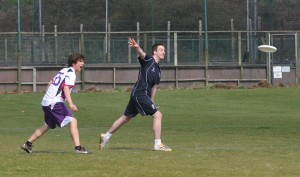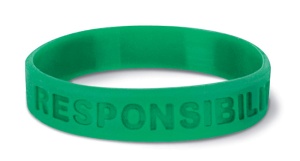I started writing a post about different styles of hucks – into space or into hands, flat or curved, break or open, stalling or lasered or bladey etc. – not advocating for any particular style, but rather discussing the advantages and disadvantages of different choices, and the kind of situations you might want to use them in.
 But after passing about 2,000 words and not having scratched the surface, I had a rethink. I’ll write a bunch of pieces, on different situations and different throws, rather than combine them all into one obnoxiously long post.
But after passing about 2,000 words and not having scratched the surface, I had a rethink. I’ll write a bunch of pieces, on different situations and different throws, rather than combine them all into one obnoxiously long post.
To lay the groundwork though, I’ll talk about a couple of things that kept coming up:
- Risk and Reward
- Shared responsibility
 First off, it’s very obvious that all throws need to balance risk and reward. Higher risk is allowable, if the reward is significantly greater (e.g. opening up the break side). For long throws, the reward is increased yardage.
First off, it’s very obvious that all throws need to balance risk and reward. Higher risk is allowable, if the reward is significantly greater (e.g. opening up the break side). For long throws, the reward is increased yardage.
Both intuition and statistics (like this graph of Nexgen 2012’s probability of scoring from different parts of the field, from this excellent Ultiworld article) will tell you that you’re more likely to score from near their endzone than from near yours. If it will take you six 95% throws to get as far as one 80% huck, then the riskier huck would on average put you ahead of the game.
The balance is often hard to find. For example, a shorter huck is both easier to throw, and gives the defence less time to get there – meaning it’s less risky. But a longer throw has a greater reward, which is a different way of tipping the risk/reward ratio in your favour. The choice will depend on many things – the weather, the skill of the thrower, the separation and speed difference between offender and defender, and much more. The decision is not easy, and it changes in real time – but there’s no doubt that some form of risk/reward calculation, whether conscious or not, needs to be part of your hucking strategy.
 Secondly, it’s worth thinking about the shared responsibility for a completion. Between them, the thrower and receiver bear 100% of the burden for a completion. But they don’t have to split that evenly, and they very rarely do in practice. In your team, who takes the most responsibility?
Secondly, it’s worth thinking about the shared responsibility for a completion. Between them, the thrower and receiver bear 100% of the burden for a completion. But they don’t have to split that evenly, and they very rarely do in practice. In your team, who takes the most responsibility?
It might be that the thrower takes the strain, trying to put a perfect throw where only the receiver can get it. It might be that the thrower puts all the responsibility on the receiver, by floating something up in the general vicinity and asking the receiver to sky people. Or it might be that the receiver takes responsibility, by making such a good cut in such a great space that the thrower has an easy task to put it out there.
This is a really interesting way to look at your team’s offence – are you frequently relying on huge grabs, or are you relying on incredibly accurate throws? Are you asking too much of your receivers, or are you asking too much of your throwers? When it goes wrong, which end of it would be easiest to improve? Should you be practising more to reduce throwing error, or trying to increase the margin of error that the thrower has to work with?
There are lots of changes you could make. If the throwers are struggling for the required distance, you could stack nearer the disc. If the throwers are missing their target too often, practice getting more spin and float so that the disc stays at a catchable height for longer. If your slow cutters are being overtaken by defenders all the time, then maybe practice putting less angle-of-attack on it and trying to hit them really fast and accurately.
Your task is to improve the completion rate, and whilst I am a huge advocate of throwing practice, that’s not always the only element you want to be looking at to get that percentage up.
The balance between the skill and power of the throwers, and the skill and speed of the cutters, will largely determine your tactical approach to long passes. I’ll discuss some broad categories of hucking styles, and the situations in which each is most effective, in future posts.
Very often, hucking is seen as the thrower’s problem. And at first, that’s certainly the case – if you’re not good enough to throw it the required distance with any consistency then it’s a throwing problem. But once you’ve established even a reasonable array of throws, you might make faster improvements by looking at the tactics your team uses to create deep opportunities or by training your receivers to cut or catch more effectively.



Good post Benji. I think the responsibility point is quite interesting and relevant to a lot of aspects of the game and it’s maybe not considered enough. Everyone wants to make the best throw or catch that they can and in doing so often reduce the completion chance. For example, anyone who knows me knows that I’m pretty comfortable indoors playing for jump balls in the endzone. In my experience I’ve found that typically, I have much better percentages with the players who understand that they don’t need to place perfect break throws out of the defenders reach and can take on an easier throw (the Dundee guys are excellent at this), playing to the combined strengths of thrower and receiver.
LikeLike
I am a very strong advocate of hucking @ 90%. Knowing that limit and practice hitting that throw constantly well from a range of pivot positions. Too many players try and throw at full whack losing control just like other sports (golf swing, cricket shots) .
LikeLike
I agree completely. In practice, work to extend your comfort zone; in the game, work within it.
LikeLike
You indicate that the main advantage of hucking is yards gained. There’s another, less tangible advantage in that a few successful hucks make playing a predominantly ‘under’ game easier. In the same way that Dave Pichler highlighted the importance of break throws in his recent piece for The Show Game, a couple of successful hucks early in the game mean that the defence will take fewer liberties marking cutters under. Furthermore the importance of yardage varies depending partly on conditions – anyone in Nottingham a couple of weeks ago can testify to that – and partly on the strength of your D line. A strong D line may see being on D near the opposition zone as an opportunity and take greater risks with long throws as a consequence.
LikeLike
That’s certainly all true. Good points. In fact, teams being scared by early hucks will make for another post… thanks for the idea!
LikeLike
Pingback: Know You’re Biased | Understanding Ultimate
Pingback: The Grapevine – 05/07 | Show Game